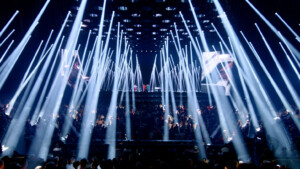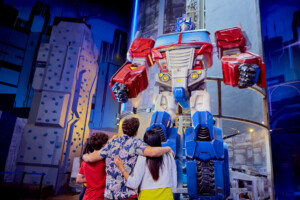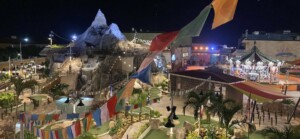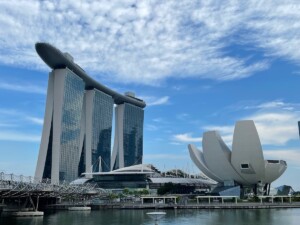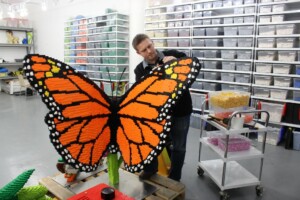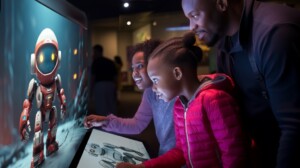The quirky street art, modern architecture and world class museums in Rotterdam, were the perfect backdrop for this year’s MuseumNext Europe 26th-28th June 2017.
Over 500 museum professionals from more than 30 countries gathered to be inspired by the latest and greatest in the industry.
The theme of this year’s MuseumNext Europe was “Gamechanging”. Fitting for the dynamic museum landscape but also for the man of the moment – and industry game changer himself – Jim Richardson, founder of MuseumNext. He has grown a “what’s next?” blog about museums eight years ago into seven museum industry events a year and a global community of professionals.
Game-changing at MuseumNext Europe

MuseumNext Europe 2017 was sponsored by Platinum sponsors Syx Ticketing and DOOR; Gold sponsors Zumtobel, Wezit, University of Glasgow, Het Nieuwe Instituut, Kunsthal, ArtFund; and Silver sponsors Leach Studios, Belasting & Douane, BECK, Master of Museology, and Vruchtvlees.
With so much to see, I explored a variety of workshops and talks held at de Doelen, as well as receptions at the Het Nieuwe Instituut and the Kunsthal all in central Rotterdam. I have highlighted a few key themes here.

A full head of STEAM
A key theme of MuseumNext Europe 2017 was the rising ‘STEM to STEAM’ mentality in museums. This is the idea that art and design play a key role in innovation and can be coupled with Science, Technology, Engineering and Mathematics in exhibits to drive change. A brilliant example was Keynote speaker Honor Harger, Executive Director at ArtScience Museum in Singapore.
Harger presented the museum’s latest permanent (yet ever changing) exhibition Future World in collaboration with TeamLab. The exhibit has 4 themes, 15 installations, and has been a huge success for the attraction.
“Future World has been a game changer for us. We had 83% increase in visitors in 2016 and it has squarely put us on the map of Singapore attractions,” said Harger.
The exhibit features interactive artworks using technology. Guests can slide down a projection mapped slide with interactive flowers and animations and can also scan in a coloured-in vehicle on paper which inserts as a 3D animation into a virtual model city. They can also interact with 80,000 LED lights in a Crystal Universe. The exhibit encourages repeat visits as each visit is unique. For example, in ‘Nature’ the animations change in real time throughout the year showing the four seasons.
Google goes wild

In addition, Harger discussed their recent project, “Into the Wild” with Lenovo, WWF, and Google – the company’s largest use of technology in museums to date. Using AR (augmented reality), a virtual rainforest is projected around the museum. Most importantly, for every virtual tree planted by a guest (with a donation to WWF) a real tree is planted in the Sumatran rainforest to combat the devastating forest fires that are destroying the habitats at an unprecedented rate.
“We can stimulate real world change from this augmented reality,” said Harger.
I wish we had had time to visit ArtScience whilst at the Asian Attractions Expo last month. We will have to go back to explore!
Technology a key driver
As always technology is a key driver in Museums – visitors now expect it, and a lot of careful consideration goes into developing the technology that adds to rather than detractes from, the visitor experience. If you can’t beat your guests with smartphones, then join them – but in a tasteful way.

We heard from Cas Boland, Head of Marketing, and Sanneke Prins, Programme Manager of Multimedia at the Van Gogh Museum on the unbelievable success of their collaboration with global DJ Armin van Buuren, #EmbraceVincent.
The museum combined the two dutch superstars in a limited edition two-month audio guide from leading creator of multimedia content and applications, Imagineear. Guests could use the multimedia player and hear from van Buuren about which paintings inspired him and hear clips of his music. Some even danced around the museum!

The power of social media
The social media statistics the Van Gogh Museum achieved from this one exhibit were incredible. Two Facebook live sessions, each lasting just twenty minutes increased the museum’s reach from 600k to 14 million people, gaining an extra 50K “likes” on their page and media exposure worth €600K. The most important benefit was reaching a new audience, and interestingly more Dutch visitors as the museum traditionally has high tourist visits.

Another talk from Tim Powell, Creative Producer at Historic Royal Palaces, highlighted the use of technology without an interface. The award winning multimedia tour The Lost Palace showcases Whitehall Palace in London. It used to contain 1,500 rooms stretching from Big Ben to Nelson’s column, however all but one room were lost in a huge fire.
They wanted to use technology to tell the story without having guests staring at a screen. “We are in an experience economy,” said Powell. “People go to Wikipedia now for facts, we need to tell stories and give people experiences”.
They came up with the simple solution, hiding the technology in a wooden case. Guests can use the uniquely shaped wooden objects to hear stories at specific points around the area, and can use the object as a sword and even a cockerel!
Events as revenue drivers and innovators
Holding events at Museums is now standard. It is an effective way to maximise revenue by selling event space, but also of opening up a museum’s reach to different audiences, for example, through “adult only” events.
One such museum doing this (but on steroids) is the Museum of Contemporary Art in Denver. We heard from Adam Lerner, the Museum’s Director and Chief Animator in his presentation, “How Not to Die of Excellence”. The Museum’s range of events, from “Bartender in Residence“, to the “XXX-Mas Craft Fair” have attracted a huge audience, as well as repeat visitors. Lerner emphasised that museums shouldn’t take themselves too seriously!

Dave Patten, Head of New Media at The Science Museum, London described how they were using events to drive innovation in the industry. The first Hackathon took place last year, resulting in a an online game and The Egg. This is a small device users can wear around the museum. At the end of their visit it identifies the exhibits they seemed to engage with and includes a print-out of extra information. Amazingly, all the code for these projects is available for any museum to use.
Strive to be different
One of the most memorable talks of MuseumNext Europe 2017, came from Claire Eva, Brand and Communications Director at 14-18 Now. I admit I had not heard of 14-18 Now before the talk, but instantly knew their projects. This is the company behind the WW1 Centenary commissions in the UK, including the Poppies exhibition (now on tour around the country) and the focus of this talk, the ‘We Are Here Because We Are Here” installation by Turner Prize-winning artist Jeremy Deller and Rufus Norris, Director of the National Theatre.

On the 1st July 2016, #WeAreHere brought together 1400 volunteers dressed as WW1 soldiers who appeared around the UK. None spoke to the public, unless they occasionally sang a war song. Instead, they handed out cards containing the name, age, regiment, location, and age of death of a soldier they represented.
340 million impressions
Eva spoke about the complex logistics of keeping the project a secret. Code names and NDAs were used. The reaction from the public was incredible. The #WeAreHere hashtag trended on twitter for 14 hours and gained 340 million impressions around the world. Incredibly, after a poll, 63% of the UK population were aware of the campaign. Furthermore, two thirds said it made the Battle of the Somme more relevant to their lives. A huge success then!
The soldiers were all volunteers from over 26 theatres around the country. They had had extensive training in what to do if the public were violent and even terrorism training. However, they were not prepared for the overwhelming emotional reaction of the public. People cried on them and hugged them. Hearing how 14-18 had turned a traditional marketing campaign on its head – to deliberately not shout about it in advance – was unique and had great take home value for the audience.
Culture at the front of an investment
Another thought provoking talk at MuseumNext Europe 2017 was from Deborah Cullinan, Yerba Buena Center for the Arts in California, which introduced the Culture Bank – a radically different funding model for social practice art and artists.
The model considers objects other than just money in the asset mix. It includes art collections and community skills. These can be valued in order to fund up and coming artists.
“Culture Bank is a new investment paradigm, putting culture at the front of any investment,” said Cullinan. It is certainly of interest to many museums perhaps who are dependent on ever-diminishing public funds.

Workshops
During the conference I visited two workshops. The first was Wezit’s augmented reality (AR) workshop, which considered why museums invest in AR and how they encourage longer engagement through apps after the visit. We also heard an honest account of the prototyping process to get the final product and how to reframe problems to find the best solution.
“If it doesn’t work with paper, it won’t work with technology,” said Wezit’s Community Engagement Facilitator Alexia Jacques-Casanova.

We were also encouraged to investigate Tinder – in a purely professional way.
“Put yourself in your user’s shoes who are used to interfaces already. Teenagers for example know to swipe left and right from Tinder, so it should be instinctive to use interfaces in the same way. The pinching motion is also a classic example”.
Engaging different types of visitor
In another hands-on workshop from the Amsterdam Museum and Guide ID, groups looked at innovative ways of using audio guides to tell the story to engage different types of visitor. These ranged from culture lovers to party-goers, and created their own audio guide on Guide ID’s Podcatcher system.
The Museum demonstrated the variety of ways in which it is using the audio guides to engage visitors. Marijke Oosterbroek is Head of e-culture at the Amsterdam Museum. He said, “Traditionally we have been very good at attracting tourists but we want to be there for the citizens of Amsterdam. We think apps and guides can be good for different groups of visitors”.

One example was the Mix and Match Museum exhibition. This involved eight local museums in Amsterdam presenting a variety of their objects online. Guests were invited to pick and choose objects to curate their own collections. Four of these collections where chosen, from adults and children, and presented at the Amsterdam Museum.
The chosen public curators were then invited to create their own audio guide to explain what attracted them to these objects. This was particularly interesting for the children, who guessed at the function of some of the objects! The museum demonstrated how you can create these tours quickly, easily, in house, and on a tight budget.
After a great couple of days in Rotterdam, I look forward to next year’s conference in London. The theme is “Future of Museums” and it takes placee June 18-21, 2018.
Images kind courtesy: ArtScience Museum, Historic Royal Palaces, Eion Carey/Glasgow, Amsterdam Museum.









